A Sure-fire Way to Win the Speech Contest (No.37)
I was intrigued by an article in the local newspaper the other day in which the Governor of the National Bank of Belgium warned about the risk of a real estate bubble in Belgium. According to the article, the Belgian real estate prices are 20 to 50 % higher than what they should be and are becoming a burden on the family budget. Actually, if you look at the past 13 years, the outstanding mortgage-backed housing loans have tripled from 67.8 billion euro to 174.2 billion euro which caused the household debt to increase significantly from 33 % to 46 % of the gross national income (GNI). Compared to the European average, the household debt in Europe only increased from 36% to 40 %. The Belgian figure of 46% is thus unusually high. Also, looking at the ratio of personal loans to the total lending from financial institutions in Belgium, this has increased from 28% to 43% in the past 5 years. It shows how these financial institutions during their business reorganization after the Lehman Shock have shifted the emphasis to personal housing loans which are considered relatively low-risk. However, financial experts say that the personal assets of the Belgians are five times the gross national income, so it is not necessary to be wary of the excessive increase of debts. By the way, outstanding housing loans in Japan amounted to 1 trillion 380 billion euro (March 2013), which is about 37 % of the gross national income and lower than the European average. The amount of new loans remains at about 150 billion euro every year, which is a drastic reduction to about half the amount at the time of the bubble economy (20 years ago). Well, considering that the population and the economic size of Belgium is one-eleventh of Japan, you can say that the outstanding housing loans per family are 40% higher than Japan. Whether this should be considered a “danger zone” is difficult to say though…
<Visit of Two Belgian Major Leading Companies>
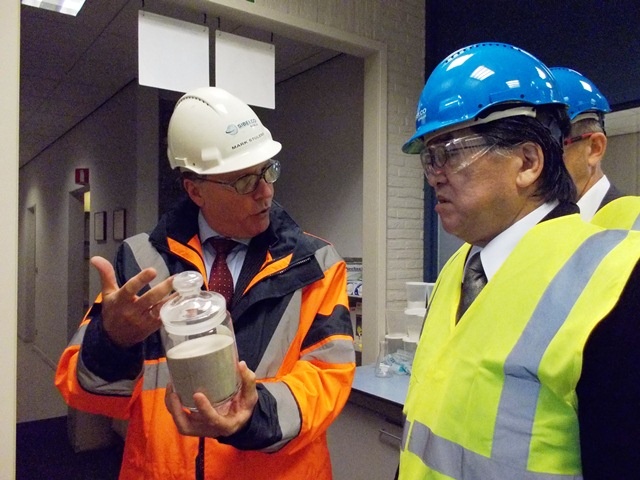 In the middle of last month, I visited Sibelco, a leading Belgian company handling various minerals for industrial use worldwide. The European headquarters are located in Antwerp, but because I wished to see the mining and manufacturing process, I visited a factory in Dessel, a small village located 60 km to the east of Antwerp. This company is mining silica sand from layers a few tens of meters below ground on the factory premises and produces large amounts of minerals for industrial use (white powder), the raw materials that can be found in expensive glass products, solar panels, computer and TV screens, etc.. The so-called silica sand is special white sand containing an extremely small amount of iron. In addition to clay for tiles, Sibelco is also mining quartz and lime. This company was founded more than 140 years ago and has now more than 200 production units (11.142 employees in total) in 41 countries worldwide. There is a subsidiary called “Sibelco Japan” in Japan, but they stopped the mining activities by last year and are now exclusively focusing on selling. AGC Glass Co. (an affiliate of ASAHI Glass Japan) is one of their main clients in Belgium. The fact that mining sand becomes a global business is indeed very interesting. In the middle of last month, I visited Sibelco, a leading Belgian company handling various minerals for industrial use worldwide. The European headquarters are located in Antwerp, but because I wished to see the mining and manufacturing process, I visited a factory in Dessel, a small village located 60 km to the east of Antwerp. This company is mining silica sand from layers a few tens of meters below ground on the factory premises and produces large amounts of minerals for industrial use (white powder), the raw materials that can be found in expensive glass products, solar panels, computer and TV screens, etc.. The so-called silica sand is special white sand containing an extremely small amount of iron. In addition to clay for tiles, Sibelco is also mining quartz and lime. This company was founded more than 140 years ago and has now more than 200 production units (11.142 employees in total) in 41 countries worldwide. There is a subsidiary called “Sibelco Japan” in Japan, but they stopped the mining activities by last year and are now exclusively focusing on selling. AGC Glass Co. (an affiliate of ASAHI Glass Japan) is one of their main clients in Belgium. The fact that mining sand becomes a global business is indeed very interesting.
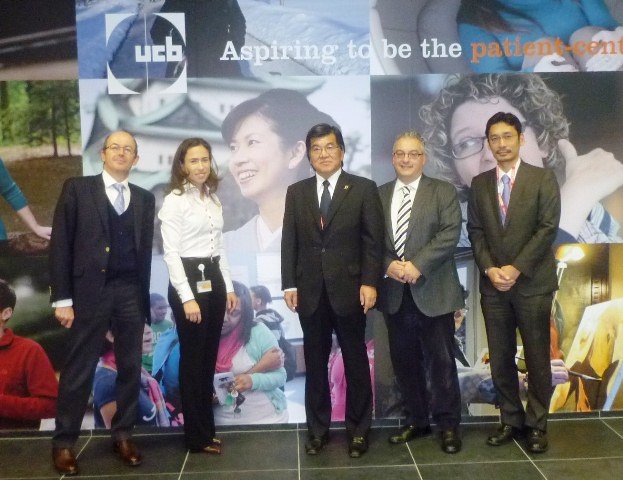 3 days ago, I visited UCB, a representative company of the pharmaceutical industry in Belgium. UCB’s 51 hectares large site on the outskirts of Braine-l’Alleud (33km south of Brussels; 38.000 inhabitants) is dotted with 21 biopharmaceutical production facilities, quite a spectacular sight. UCB employs 9000 people in a business network operating in 35 countries. Last year, the turnover amounted to 3.4 billion euro, which makes it one of the biggest companies in Belgium, but in terms of the international pharmaceutical industry it seems to be still a medium sized company. The company is specialized in the production of pharmaceutical products in the field of neurological and immune disorders and shows a strong presence in remedies for diseases such as Parkinson's disease and epilepsy. However, in the future UCB plans to launch strong products which are attracting global attention such as a medicine for osteoporosis and the turnover as well is expected to grow significantly in the next few years. In Japan, there is a subsidiary in charge of Research & Development in Tokyo and a subsidiary for packaging in Saitama Prefecture with a work force of 325 people in total. Also, in recent years UCB entered into business partnerships with Japanese pharmaceutical companies such as Astellas Pharma and Otsuka Pharma and is focusing on promoting sales. UCB was originally founded in 1928 as a manufacturer of chemicals and only expanded into the field of pharmaceuticals 28 years ago (1985). Then, they stopped the production of chemicals in 2004, acquired a British biopharmaceutical manufacturer and founded the factory in Braine-l’Alleud. It is a bold survival strategy. 3 days ago, I visited UCB, a representative company of the pharmaceutical industry in Belgium. UCB’s 51 hectares large site on the outskirts of Braine-l’Alleud (33km south of Brussels; 38.000 inhabitants) is dotted with 21 biopharmaceutical production facilities, quite a spectacular sight. UCB employs 9000 people in a business network operating in 35 countries. Last year, the turnover amounted to 3.4 billion euro, which makes it one of the biggest companies in Belgium, but in terms of the international pharmaceutical industry it seems to be still a medium sized company. The company is specialized in the production of pharmaceutical products in the field of neurological and immune disorders and shows a strong presence in remedies for diseases such as Parkinson's disease and epilepsy. However, in the future UCB plans to launch strong products which are attracting global attention such as a medicine for osteoporosis and the turnover as well is expected to grow significantly in the next few years. In Japan, there is a subsidiary in charge of Research & Development in Tokyo and a subsidiary for packaging in Saitama Prefecture with a work force of 325 people in total. Also, in recent years UCB entered into business partnerships with Japanese pharmaceutical companies such as Astellas Pharma and Otsuka Pharma and is focusing on promoting sales. UCB was originally founded in 1928 as a manufacturer of chemicals and only expanded into the field of pharmaceuticals 28 years ago (1985). Then, they stopped the production of chemicals in 2004, acquired a British biopharmaceutical manufacturer and founded the factory in Braine-l’Alleud. It is a bold survival strategy.
<Lecture at the University of Liège>

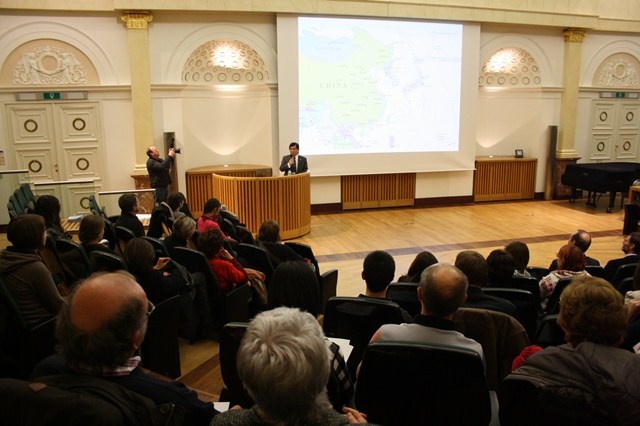 Last month, I visited the University of Liège where I gave a lecture of about one hour on the theme “Japan of Today and its Future” in front of the Vice-Rector Albert Corhay, other academics and about 150 students. The University of Liège, located 100 km to the east of Brussels, is one of the 3 biggest universities in Wallonia with about 21.000 students. I visited the University of Liège soon after my arrival nearly one year ago. Rector Bernard Rentier told me about the current state of the university and the relations with Japan. 22% of the students are international students from abroad, but there are no Japanese students. The amazingly large main campus of 750 ha is located in a natural park on the outskirts of Liège. The university itself was founded in 1817 before the independence of Belgium (during the Dutch rule) and they moved to the current campus about 45 years ago. Under the leadership of Professor Andreas Thele (a German who studied at Tsukuba University about 20 years ago) a “Centre of Japanese Studies” was established about 4 years ago in this university. In addition to the study of Japanese, the study of the history, culture and society of Japan as well is incorporated into the educational curriculum. My lecture took place at the Academic Hall in the heart of the city. It is a magnificent building where a big relief of the Dutch king, standing on a tiered platform from the time of the foundation of the university, adorns the front centre of the main hall. I gave my lecture in French and I was very glad that the students eagerly listened to my speech. Most students stayed for the screening of the Japanese movie after the lecture, so I think it was a meaningful introduction to Japan. Last month, I visited the University of Liège where I gave a lecture of about one hour on the theme “Japan of Today and its Future” in front of the Vice-Rector Albert Corhay, other academics and about 150 students. The University of Liège, located 100 km to the east of Brussels, is one of the 3 biggest universities in Wallonia with about 21.000 students. I visited the University of Liège soon after my arrival nearly one year ago. Rector Bernard Rentier told me about the current state of the university and the relations with Japan. 22% of the students are international students from abroad, but there are no Japanese students. The amazingly large main campus of 750 ha is located in a natural park on the outskirts of Liège. The university itself was founded in 1817 before the independence of Belgium (during the Dutch rule) and they moved to the current campus about 45 years ago. Under the leadership of Professor Andreas Thele (a German who studied at Tsukuba University about 20 years ago) a “Centre of Japanese Studies” was established about 4 years ago in this university. In addition to the study of Japanese, the study of the history, culture and society of Japan as well is incorporated into the educational curriculum. My lecture took place at the Academic Hall in the heart of the city. It is a magnificent building where a big relief of the Dutch king, standing on a tiered platform from the time of the foundation of the university, adorns the front centre of the main hall. I gave my lecture in French and I was very glad that the students eagerly listened to my speech. Most students stayed for the screening of the Japanese movie after the lecture, so I think it was a meaningful introduction to Japan.
<Judge at the Japanese Speech Contest>
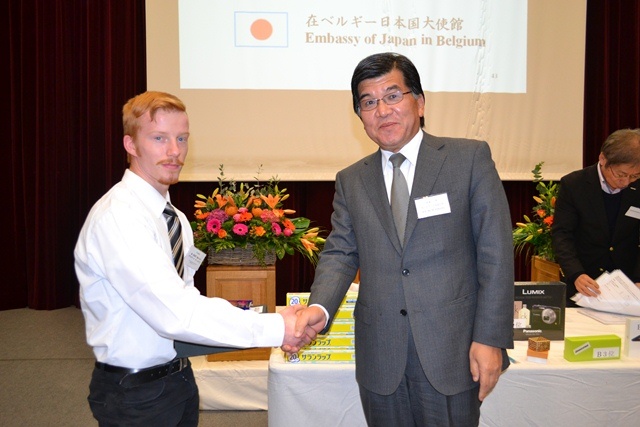
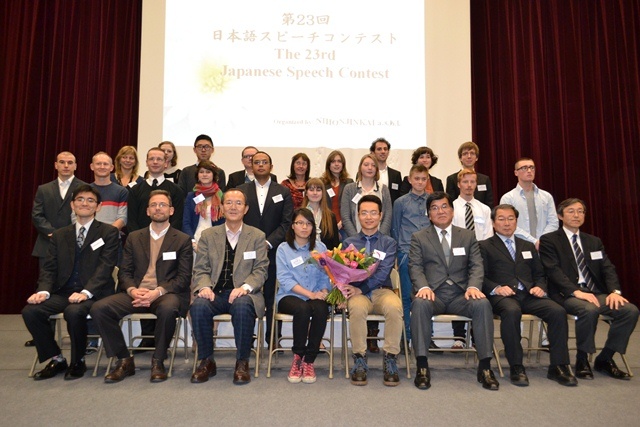 Last month, the Japanese speech contest organized by Nihonjinkai was held where, like last year, I acted as a judge (5 in total) again. In total, there were 20 competitors at the final stage: 6 people in group A (beginners) and 14 people in group B (advanced learner), which is two people more than last year (See Ambassador’s Chat No. 2). Most of the participants are university students, but also high school students and a man of nearly 50 years old participated, so the age range was wide as well. Group B showed a fierce battle, but the merits of the candidates were decided based on the following two points: “could they give a lively speech without looking at the text?” and “Did they pick up fun topics compelling to the audience?”. Talking about heart-warming episodes based on real experience can attract the judges’ attention. And then, the question-and-answer session by the jury after the speech is a trap. Even if their speech was good, many participants fail at this stage. Depending on the difference in the degree of difficulty of the questions, it seemed that you either could be lucky or have bad luck. The winner of group B was a Chinese student who got the second prize last year. The second and third prizes were taken by Belgian students. As non-Belgians got the 1st to 6th prize last year, I have the impression that the Belgian participants fared better this year. I awarded the Ambassador’s prize for encouragement, a prize that was created last year, to a young man of group A. After graduating from a high school of engineering, he works now as a garage mechanic. He told us that after he had started to learn judo, he also came to like studying Japanese. Although his speech was not great, I could feel his enthusiasm for learning Japanese. I hope that all participants will continue to study Japanese, aiming for further progress. Last month, the Japanese speech contest organized by Nihonjinkai was held where, like last year, I acted as a judge (5 in total) again. In total, there were 20 competitors at the final stage: 6 people in group A (beginners) and 14 people in group B (advanced learner), which is two people more than last year (See Ambassador’s Chat No. 2). Most of the participants are university students, but also high school students and a man of nearly 50 years old participated, so the age range was wide as well. Group B showed a fierce battle, but the merits of the candidates were decided based on the following two points: “could they give a lively speech without looking at the text?” and “Did they pick up fun topics compelling to the audience?”. Talking about heart-warming episodes based on real experience can attract the judges’ attention. And then, the question-and-answer session by the jury after the speech is a trap. Even if their speech was good, many participants fail at this stage. Depending on the difference in the degree of difficulty of the questions, it seemed that you either could be lucky or have bad luck. The winner of group B was a Chinese student who got the second prize last year. The second and third prizes were taken by Belgian students. As non-Belgians got the 1st to 6th prize last year, I have the impression that the Belgian participants fared better this year. I awarded the Ambassador’s prize for encouragement, a prize that was created last year, to a young man of group A. After graduating from a high school of engineering, he works now as a garage mechanic. He told us that after he had started to learn judo, he also came to like studying Japanese. Although his speech was not great, I could feel his enthusiasm for learning Japanese. I hope that all participants will continue to study Japanese, aiming for further progress.
<The Gallo-Roman Museum in Tongeren>
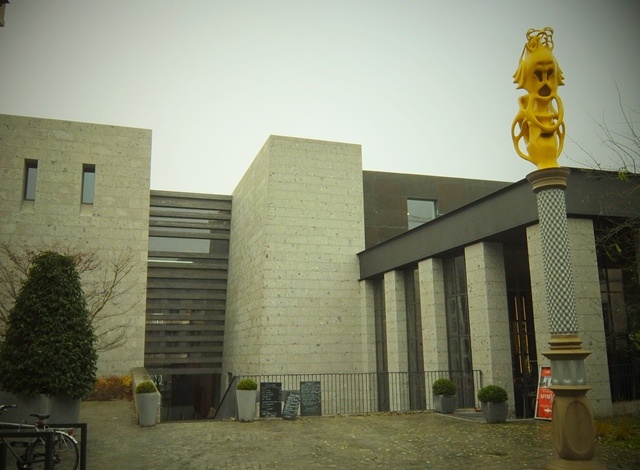 When you live in Belgium and visit the regions, you actually feel the cultural richness of this country. Last month, I visited the “Gallo-Roman Museum” in Tongeren, a city about 85km to the northeast of Brussels, and I was amazed at the splendid exhibition. It is known that Tongeren has been conquered by Caesar in ancient Roman times and a city was built there, but still today artefacts of those times are excavated and the various items on display in the museum are truly impressive. On the day that I visited, a “special exhibition on the Etruscans” took place. The exhibition was presented in such a way that one gets a complete picture of the Etruscan culture (heyday 7-6th century BC), predecessor of the ancient Roman culture. It also seems to be a popular museum for children. Several groups of primary school children were visiting the museum and the director who guided me around told me that “there are many museums to which parents take their children, but this a museum to which children take their parents”. The museum was built originally in 1950, but it was fully renovated a couple of years ago and was transformed into a very modern interior and exterior. Two years ago the museum has been awarded “Best Museum in Europe”, which guarantees the excellence of the exhibition. I recommend visiting the museum by all means. When you live in Belgium and visit the regions, you actually feel the cultural richness of this country. Last month, I visited the “Gallo-Roman Museum” in Tongeren, a city about 85km to the northeast of Brussels, and I was amazed at the splendid exhibition. It is known that Tongeren has been conquered by Caesar in ancient Roman times and a city was built there, but still today artefacts of those times are excavated and the various items on display in the museum are truly impressive. On the day that I visited, a “special exhibition on the Etruscans” took place. The exhibition was presented in such a way that one gets a complete picture of the Etruscan culture (heyday 7-6th century BC), predecessor of the ancient Roman culture. It also seems to be a popular museum for children. Several groups of primary school children were visiting the museum and the director who guided me around told me that “there are many museums to which parents take their children, but this a museum to which children take their parents”. The museum was built originally in 1950, but it was fully renovated a couple of years ago and was transformed into a very modern interior and exterior. Two years ago the museum has been awarded “Best Museum in Europe”, which guarantees the excellence of the exhibition. I recommend visiting the museum by all means.
|